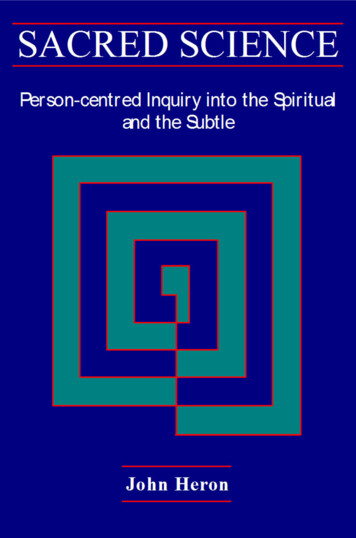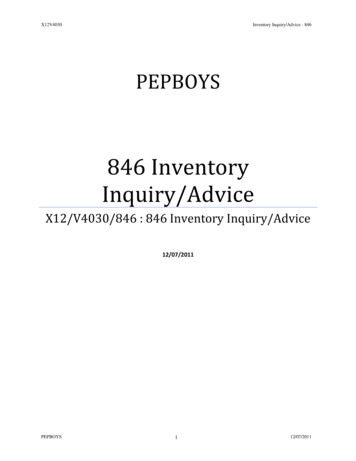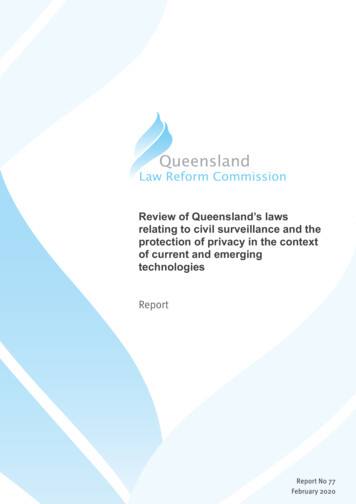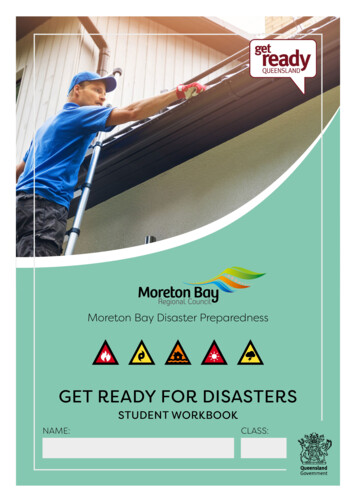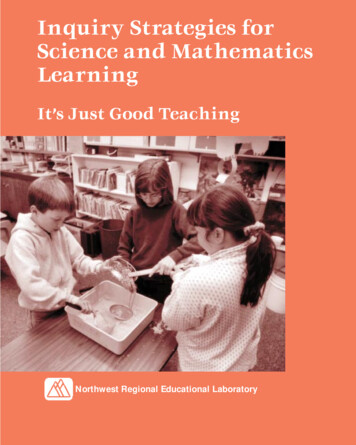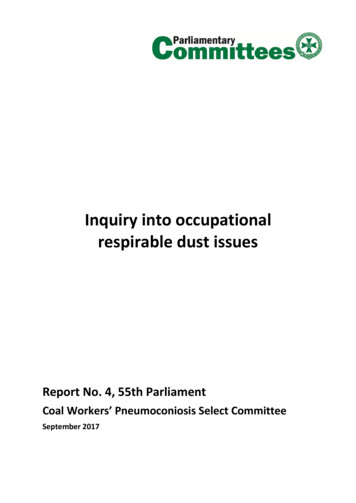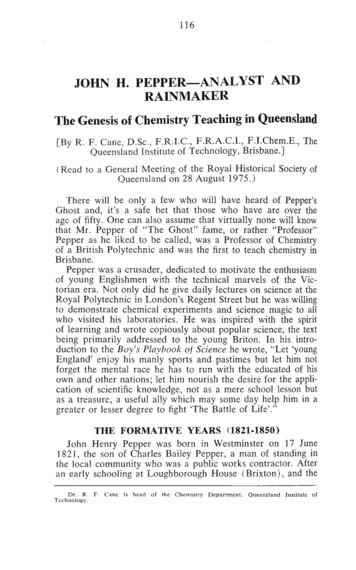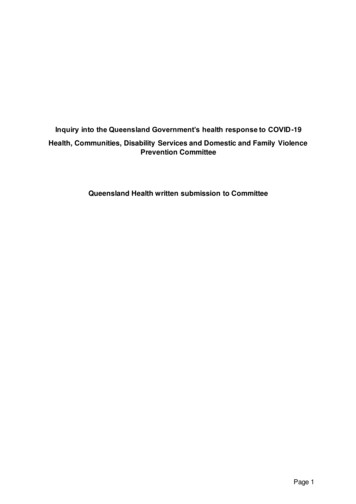
Transcription
Inquiry into the Queensland Government’s health response to COVID-19Health, Communities, Disability Services and Domestic and Family ViolencePrevention CommitteeQueensland Health written submission to CommitteePage 1
Health, Communities, Disability Services and Domestic and Family ViolencePrevention Committee’s Inquiry into the Queensland Government’s healthresponse to COVID-19ContentsIntroduction . 4Governance Structures for Queensland Health’s COVID-19 Response . 6Legislative and regulatory response . 8Understanding and mapping COVID-19. 10Preparedness for a pandemic . 12Primary Health Networks/Primary Care . 15Preparedness in prison. 15Hospital and ICU capacity . 16Hospital and Health Service staffing. 17Public Sector Workforce Mobility . 17External Expressions of Interest. 17Contact Tracing . 17Health Practitioner. 18Nursing and Midwifery Staff . 19Rural and Remote. 19Modelling of Workforce Requirements . 20Employment Relations . 20Safety and Wellbeing . 21COVID-19 testing and fever clinics . 21Testing regime . 21Australian Department of Health Point of Care Testing (PoCT) Program . 22Fever clinics . 22Ventilators, personal protective equipment and other equipment . 22Elective surgery and cancer screening . 24Mental health and wellbeing . 25Immediate response . 26Mortuary Capacity Planning . 26Older Queenslanders, Queenslanders with Disability and Culturally and LinguisticallyDiverse (CALD) communities response . 27Older Queenslanders . 27Queenslanders with Disability . 27CALD Communities . 28First Nations preparedness and response . 28Page 2
Understanding and mapping COVID-19. 28Legislative and regulatory response . 29Preparedness for a pandemic . 29Surge Workforce . 30Contact Tracing . 30Testing regime . 31Chief Health Officer Public Health Directions . 31Queensland Ambulance Service preparedness and response . 31Context . 32QAS Disaster Management Capability . 32QAS Pandemic Planning . 33QAS Planning – COVID-19. 33Coordination. 34Service Delivery . 36Staff and Patient Safety. 37Public Information and Employee Communication. 38Operational Response. 38Conclusion. 38Chief Health Officer Public Health Directions . 39Enforcement of health measures . 40Communications. 43Appendix 1 – List of Abbreviations and Acronyms . 46Page 3
IntroductionIn lodging this submission, it is important to acknowledge the context in which Queenslandfinds itself today – the State continues to be in the grips of a global pandemic. This submissionis being lodged on a day that sees the number of global cases of COVID-19 exceeding8,000,000 and the number of deaths related to COVID-19 exceeding 400,000 (including thedeaths of 102 Australians).In December 2019, a new coronavirus emerged in Wuhan City, in the Hubei Province of China,with the World Health Organization (WHO) confirming evidence of human to humantransmission. Coronaviruses are a large family of viruses that can cause illnesses ranging fromthe common cold through to Severe Acute Respiratory Syndrome (SARS) and Middle EastRespiratory Syndrome (MERS). The disease caused by the new virus is known as COVID-19.The Queensland Government acted early and decisively to respond to the threat of COVID19. The State Health Emergency Coordination Centre (SHECC) was activated to respond tothe COVID-19 pandemic on 25 January 2020.SHECC is stood up as an emergency coordination centre focused on ensuring an effective,coordinated response by Queensland Health, which comprises the Department of Health andthe 16 Hospital and Health Services (HHSs), during any disaster or event that affects one ormore of the Hospital and Health Services, or to support major events of significance like theCommonwealth Games and G20. SHECC functions include coordination of information,reporting, planning and logistic support to operations.SHECC also embedded Liaison Officers from several other government agencies, includingrepresentatives from Queensland Ambulance Service (QAS), Queensland Police Service(QPS), Queensland Fire and Emergency Services (QFES), Department of Education (DoE),Department of Communities, Disability Services and Seniors (DCDSS), Department ofAgriculture and Fisheries (DAF), Local Government representatives and the AustralianDefence Force (ADF).Furthermore, the State Disaster Coordination Centre (SDCC) was activated to coordinate thewhole of government response in support of Queensland Health as the lead agency for thepandemic. Queensland Health is the lead agency for the response functions of public health,mental health and medical services under the Queensland State Disaster Management Plan,and the primary agency for four of the nine specific hazards listed in the plan: pandemic,biological, radiological and heatwave.On 29 January 2020, the Honourable Steven Miles MP, then Minister for Health and Ministerfor Ambulance Services declared a public health emergency (COVID-19 emergency) for all ofQueensland, under section 319 of the Public Health Act 2005 (Public Health Act) due to theoutbreak of COVID-19 in China, its pandemic potential due to cases spreading to othercountries and the public health implications within Queensland. A declared public healthemergency activates a range of powers and functions under chapter 8 of the Public Health Act.Queensland was the first State or Territory in Australia to declare this public health emergency,several other jurisdictions did so under their respective legislation shortly after. A QueenslandHealth Public Health Incident Management Team was established to support the COVID-19emergency.Under the Queensland disaster management arrangements, when a state-wide disaster isdeclared, the SDCC is stood up, led by the State Disaster Coordinator under the direction ofthe Queensland Disaster Management Cabinet Committee. The SDCC and State DisasterCoordination Group (SDCG) were mobilised following the declaration of the public healthPage 4
emergency to support Queensland Health as a response lead and to ensure whole-ofgovernment awareness and coordination in planning its pandemic response.On 30 January 2020, the WHO declared COVID-19 outbreak as a public health emergency ofinternational concern.On 1 February 2020, the Prime Minister of Australia, based on updated health advice from theCommonwealth’s Chief Medical Officer and the Australian Health Protection PrincipalCommittee (AHPPC), introduced entry restrictions on foreign nationals who had been inmainland China from 1 February 2020 onwards. On 5 February 2020, Queensland Healthintroduced screening at Queensland’s international airports (Brisbane, Cairns and Gold Coast)and required all travelers who had been in mainland China from 1 February 2020 to selfquarantine for 14-days.On 26 February 2020, AHPPC recommended that surveillance should be maintained tofacilitate COVID-19 testing in symptomatic returned travelers from South Korea, Iran, Japan,Italy, Hong Kong, Thailand and Indonesia. On 29 February 2020, the Australian Governmentannounced entry restrictions on foreign nationals who had been in Iran from 1 March 2020onwards. On 5 March 2020, the Australian Government announced entry restrictions onforeign nationals who had been in South Korea from 5 March 2020 onwards.On 11 March 2020, the Director-General of the WHO declared COVID-19 a global pandemic.The Public Health and Other Legislation (Public Health Emergency) Amendment Act 2020(Public Health Emergency Act) was urgently passed by Parliament on 18 March 2020. Amongother amendments, the Public Health Emergency Act amended the Public Health Act tostrengthen powers of the Chief Health Officer and emergency officers for the COVID-19emergency to implement social distancing measures, including regulating mass gatherings,isolating or quarantining people suspected or known to have been exposed to COVID-19 andprotecting vulnerable populations, such as the elderly. In particular, the Chief Health Officerwas empowered to make a Public Health Direction if they reasonably believe the Direction isnecessary to assist in containing or responding to the spread of COVID-19 within thecommunity.The impact of the restrictions being imposed has been significant both for individuals andbusinesses. While essential services have been maintained, individuals have had theirmovement restricted for non-essential purposes and non-essential businesses have beenunable to operate. Looking forward, as discussion turns to the easing of restrictions, thesuppression of the virus means that Queensland is now well-placed to reopen our economywhile also effectively manage any increased cases or localised outbreaks of COVID-19.At the national level, the National Cabinet has provided an overarching governancemechanism for coordinated decision-making and nationally consistent responses across allAustralian jurisdictions. Led by the Prime Minister and First Ministers from each state andterritory, the National Cabinet has worked to enable a coordinated national response with inputfrom all jurisdictions on the pandemic response, while allowing for flexibility so that responsesare tailored to each jurisdiction’s unique circumstances. National Cabinet decision-making isstrongly informed by advice from the AHPPC, which is chaired by the Australian Chief MedicalOfficer and comprised of all jurisdictions’ Chief Health Officers and a com prehensive panel ofmulti-disciplinary experts.The COVID-19 pandemic had and continues to have the potential to be catastrophic forQueensland if not managed correctly. The restrictions that have been put in place inQueensland have meant that the uncontrolled outbreaks seen in some overseas jurisdictionshave been avoided. Queensland has had time to consider and develop our health system toPage 5
be able to respond to any outbreaks, to meet the needs of unwell Queenslanders and to ensurethe safety of front-line staff. Our health system has continued to respond to emergencies andaddress the needs of those most unwell in our community, including urgent non-COVID-19related cases.Queensland Health’s early preparedness, ongoing leadership and investment in technology toimprove health service outcomes meant that it was well positioned to rapidly upscale andsupport virtual models of care and alternate working arrangements in response to COVID-19restrictions and distancing requirements.Queensland Health has established clear processes to source Personal Protective Equipment(PPE), establish urgent additional space and equipment for COVID-19 cases, if required, andto support contact tracing when cases do occur. These baseline requirements are a result ofthe early and ongoing efforts of the health system in responding to the COVID-19 pandemic.Governance Structures for Queensland Health’s COVID-19 ResponseThe effective coordination and collaboration across all levels of government, Queenslandgovernment portfolios, within Queensland Health and HHSs and the health system morebroadly, has been central to our ability to determine strategic priorities and rapidly mobiliseresources to enable swift and targeted action. This was enabled by the establishment andQueensland Health’s contribution to several governance mechanisms that bring togetherclinicians, multi-disciplinary experts, senior public and health care administrators andgovernment leaders at the national, state, local and Queensland Government’s intradepartmental levels. These are in addition to our ‘Business as Usual’ governancearrangements.These groups have to date successfully operationalised Queensland’s State DisasterManagement Plan and the Queensland Health Disaster and Emergency Incident Plan(QHDISPLAN) and the Australian Government Australian Health Sector Emergency ResponsePlan for Novel Coronavirus (the COVID-19 Plan) to respond the COVID-19 Pandemic and willplay a leading role in Queensland’s Roadmap to Recovery.In responding to COVID-19 Queensland Health has been leading the public health responseand also responding to the impact of the pandemic on the delivery of health services. Thepublic health response includes but is not limited the finding, isolating and testing of cases andcontacts, and monitoring and advising on the appropriate response to the pandemic. Thepandemic health response include but is not limited to the health systems capacity to supportthe public health response, and surge planning ensure capacity to treat and manage casesand to ensure continued delivery of essential health services, including emergency care,cancer treatment and obstetric services.Queensland Health established two internal key governance mechanisms, the PandemicHealth Leadership Response Team (PHLRT) and the Pandemic Health ResponseImplementation Advisory Group (PHRIAG), that harnesses the diverse set of expertise acrossthe Department and HHSs to develop and guide the implementation of our tactical responseto the COVID-19 Pandemic.PHRLT members were each assigned a portfolio lead area of accountability. Health ServicesChief Executives (HSCEs) nominated a partner HSCE for each PHRLT member in an advisoryand support capacity.In the early stages of the COVID-19 response, PHLRT meetings and meetings betweenPHLRT and HSCEs were held daily to discuss issues impacting on the broader system,particularly the hospital preparedness activities. As matters were resolved and planningactivities continued, the frequency of these meetings has decreased.Page 6
These groups were supported by the creation of a comprehensive administrative machineryarticulated under various streams to support the demanding strategic and operational functionsof our COVID-19 response. For example, the Office of Rural and Remote Health Establishment(ORRHE), leveraging off the priority planning for Remote Discrete First Nations communities,in partnership with the Aboriginal and Torres Strait Islander Health Division (A&TSIHD),developed a community preparedness planning document, COVID-19 Rural and Remotecommunity planning resource and checklists, to provide a strategic outline of a community’sresponses to the COVID-19 pandemic.Page 7
Note: Roles and responsibilities of PHLRT members were subject to change over the course of theresponse to address emerging issues and priorities.Legislative and regulatory responseQueensland was the first State or Territory to declare a public health emergency, with mostStates and Territories not declaring an emergency under their respective legislation until earlyor mid-March 2020. Declaring a public health emergency under the Public Health Act enabledemergency officers and others to commence issuing quarantine notices and take measures tocontrol the spread of COVID-19 before it became unmanageable.Following the declaration of the public health emergency, urgent legislative measures weretaken to strengthen the ability of public officials to contain and respond to the spread of COVID19 within the community.On 30 January 2020, the Public Health (Coronavirus (2019–nCoV)) Amendment Regulation2020 was made. The regulation prescribed COVID-19 (then referred to as ‘coronavirus 2019nCoV’) as a controlled notifiable condition and a condition requiring immediate notification. Thepurpose of the regulation was to ensure that Queensland Health was able to understand theepidemiology of the virus and manage any potential outbreaks in Queensland.On 5 and 6 February 2020, regulations were made to extend the period of the declared publichealth emergency until 12 February and 19 February 2020 respectively. On 7 February 2020,the Public Health (Declared Public Health Emergencies) Amendment Act 2020 was enactedto allow the period of the declared public health emergency to be further extended by regulationfor periods of up to 90 days. The declared public health emergency was subsequentlyextended to 19 May 2020 and again to 17 August 2020.On 18 March 2020, Parliament passed the Public Health and Other Legislation (Public HealthEmergency) Amendment Act 2020 (Public Health Emergency Act) to strengthen powers of theChief Health Officer and emergency officers appointed under the Public Health Act toimplement social distancing measures, including regulating mass gatherings, isolating orquarantining people suspected or known to have been exposed to COVID-19 and protectingvulnerable populations such as the elderly and remote communities with a high Aboriginal andTorres Strait Islander population. In particular, the Chief Health Officer was empowered tomake Public Health Directions that are reasonably necessary to assist in containing, orresponding to, the spread of, COVID-19 within the community.Several regulations were also made to prescribe police officers, fire service officers andharbour masters as additional categories of persons who may be appointed as emergencyofficers (general) under section 333 of the Public Health Act.On 22 April 2020, building on the initial legislative response, Parliament passed the COVID-19Emergency Response Act 2020. This Act established a modification framework of generalapplication across the Queensland statute book. Under the modification framework,government departments, courts and other entities may make statutory instruments and/orpropose ‘extraordinary regulations’ that directly modify Acts of Parliament with respect tostatutory timeframes, proceedings of courts and tribunals, and provisions relating to physicaldocuments or physical attendance at places or meetings. The powers may only be exercisedto the extent necessary: to protect the health, safety and welfare of persons affected by theCOVID-19 emergency; to facilitate the continuance of public administration, judicial process,small business and other activities disrupted by the COVID-19 emergency; or to achieve otherspecific purposes of the COVID-19 Emergency Response Act.Page 8
In reliance on these powers, several extraordinary regulations and statutory instruments weremade to support Queensland Health’s ability to respond to COVID-19. These extraordinarypowers and any regulations and instruments made under them are subject to safeguards andwill sunset on 31 December 2020.On 18 May 2020, the Health (Drugs and Poisons) Amendment Regulation 2020 was made tostreamline service delivery and reduce physical contact for vulnerable patients during theCOVID-19 pandemic. Specifically, the regulation allows certain drugs to be prescribed anddispensed based on a digital image of a prescription in accordance with the National Health(COVID-19 Supply of Pharmaceutical Benefits) Special Arrangement 2020 (Cth).On 21 May 2020, as a further legislative response to the pandemic, Parliament passed theJustice and Other Legislation (COVID-19 Emergency Response) Amendment Act 2020(COVID Amendment Act). This Act addressed matters that could not be dealt with under themodification framework established by the COVID Act.Significantly, the Justice and Other Legislation (COVID-19 Emergency Response) AmendmentAct amended the Public Health Act to: clarify that public health directions can be given to a parent on behalf of a child; clarify that public health directions can commence after they are published; authorise additional delegates to share information for contact tracing (includinginformation from the Notifiable Conditions Register); and extend certain timeframes that apply to detention orders from 96 hours to 14 days,consistent with the powers of emergency officers to detain persons for up to 14 daysunder amendments made by the Public Health Emergency Act.The Justice and Other Legislation (COVID-19 Emergency Response) Amendment Act alsoamended the Private Health Facilities Act 1999 to allow the Chief Health Officer to waivelicense fees incurred by private health facilities that furnish assistance to the State during itsresponse to COVID-19 and amended the Mental Health Act 2016 to ensure continuity of carefor mental health patients and to enable mental health patients to comply with public healthdirections, including orders to isolate or quarantine at particular places.The changes provide that the Chief Psychiatrist may approve the absence of particularinvoluntary patients from an Authorised Mental Health Service if satisfied the absence isnecessary to comply with an order or direction given under the Public Health Act. In order toapprove an absence, the Chief Psychiatrist must be satisfied that the treatment and care needsof the person can be met in the community for the period of absence and that the absence willnot result in an unacceptable risk to the person’s safety and welfare, or to the safety of thecommunity.In addition, to expedite current administrative processes and enable continuity of treatment toinvoluntary patients during the COVID-19 pandemic, the Justice and Other Legislation(COVID-19 Emergency Response) Amendment Act has been modified to allow the ChiefPsychiatrist to declare an Authorised Mental Health Service or appoint an administrator of anAuthorised Mental Health Service via publication on a Queensland Health website, rather thanbeing required to utilise the Government Gazette process.The Justice and Other Legislation (COVID-19 Emergency Response) Amendment Act expireson 31 December 2020, except for the amendments to the Public Health Act in relation todetention orders, which will expire on 19 March 2021.Page 9
Understanding and mapping COVID-19Since late 2019, Queensland Health had been closely monitoring the situation and spread ofCOVID-19 internationally and assessing the risk to Queensland which led to advice beingprovided to the Honourable Steven Miles MP, then Minister for Health and Minister forAmbulance Services, to declare a public health emergency under the Public Health Act on 29January 2020.Queensland Health’s initial intelligence on COVID-19 was informed by announcements by theWHO, and advice from the AHPPC, who was in turn advised by the Communicable DiseasesNetwork Australia (CDNA). On 21 January 2020, WHO issued its first situation report onCOVID-19. On 30 January 2020, WHO’s Director-General declared the outbreak of COVID-19a Public Health Emergency of International Concern. The WHO issued recommendations that“all countries should be prepared for containment, including active surveillance, earlydetection, isolation and case management, contract tracing and prevention of onward spread.”On 24 February 2020, WHO’s Director-General affirmed that COVID-19 had pandemicpotential, and that “this is a time for all countries, communities, families and individuals to focuson preparing.”Using Commonwealth modelling and partnering with the Commonwealth Scientific andIndustrial Research Organisation (CSIRO) Collaborative, Queensland Health has developedits own modelling which is made available to approved stakeholders, in particular Hospital andHealth Services, on the internal System Performance Reporting (SPR) platform and via dailyreports. This modelling has been independently assured and validated by the University ofWestern Australia and includes forecasting of: the effective transmission rate (R0) hospital bed and Intensive Care Unit (ICU) capacity requirements (including ventilators)with a linkage to Queensland Health’s COVID Response Framework medication needs for COVID-19 patients and maintaining business as usual services COVID-19 cases by Hospital and Health Service and what this means for Queensland’spublic health system.Queensland Health has actively monitored key information to inform its response to mattersrelating to the COVID-19 pandemic, including supply and availability of PPE and otherconsumables such as disinfectant, availability of ICU beds, number of COVID-19 casesincluding the source of infection, locations and recovery, deaths from COVID-19. This wasenabled through rapid development of data analytics and dashboards that integrated data frommultiple, existing health systems and new patient management and tracing tools developedfor COVID-19.On 16 April 2020, the Australian Government released modelling outlining the impact ofCOVID-19 in Australia. Nowcasting uses Australian data from the previous 14 days to moreaccurately understand the present state of the epidemic. Model forecasts can be projected toestimate what the next fortnight will bring based on the current rate of epidemic growth. Theseforecasts can be used to review the effectiveness of current measures, inform future responsestrategies and predict the likely course of the pandemic over time.To support the strategy of suppression of COVID-19, the Australian National DiseaseSurveillance Plan For COVID-19 (Surveillance Plan) was developed and released on 29 May2020 to guide the collection of comprehensive health data to enable us to understand thecharacteristics and time-trends of COVID-19 in Australia.Page 10
For national COVID-19 suppression strategies to be effective, effective reproduction rate (Reff)must be less than one. This means that every person who contracts COVID-19, on average,will transmit the virus to less than one other person. It is expected that the health system willbe able to cope with projected peak/increases in cases if strategies to contain and trace casesare continued, as well as physical distancing and good hy
Furthermore, the State Disaster Coordination Centre (SDCC) was activated to coordinate the whole of government response in support of Queensland Health as the lead agency for the pandemic. Queensland Health is the lead agency for the response functions of public health,


